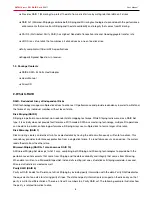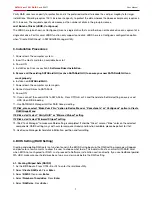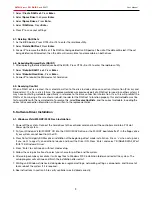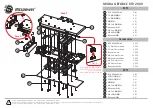
SATAII 4 port PCI RAID Card
RC217 User Manual
3
Q5: What is Raid1?
A5: RAID1 also known as Mirroring or SAFE. Mirroring creates an identical twin for a selected disk by having the data
simultaneously written to two disks. If a read failure occurs on one drive, the system will read the data from the other
drive. Raid1 need two drives to store the same data.
Q6: What is Raid10?
A6: RAID10 also known as RAID 0+1 or Mirrored-Striping or “SAFE and FAST”. RAID10 combine both Striping and
Mirroring technologies to provide both the performance enhancements that come from Striping and the data availability
and integrity that comes from Mirroring. There are at least four hard drives is need for RAID10 setting.
Q7: What is RAID5?
A7: RAID5 also known as Distributed Parity RAID. RAID 5 adds fault tolerance to Disk Striping by including parity
information with the data. The data and parity information is arranged on the disk array so that parity is written to
different disks. There are at least three hard drives is need for RAID5 setting.
Q8: What is JBOD?
A8: The JBOD (Just a Bunch of Disks , also known as Contiguous) means a single logical drive that can either be an entire
disk drive or a segment of a disk drive. JBOD is the Contiguous configuration option when creating RAID Groups (or sets)
in the SATARAID5 Manager utility.
Q9: What is CONCATENATED?
A9: Concatenated also known as Big Drive, The Concatenated combines multiple disks or multiple segments of disks
into a single large disk. It does not provide any data protection or performance improvement but can be useful for utilizing
leftover space on all disks.
Q10: How to make sure RAID5 setting is ready for working?
A10: RAID5 setting may cost hours for component ready and function available, please be patient for that. Especially if Raid5
setting by BIOS, please Click “Task Manager” to make sure there is “Green” color on the selected components and then
Raid5 setting is completed.
Q11: May use the existing used hard drive to RAID5 Card?
A11: Yes, it is workable. But, the working data on your existing used HDD may NOT work and be treated as a blank
drive when you migrate it to RAID5 Card environment.
Q12: Why Windows Device Manager can NOT detect my hard drives, but BIOS can detect it?
A12: In RAID storage system, RAID managing information is saved on the drive. If without the correct RAID
Creating by BIOS or GUI, Windows Device Manager can NOT recognize the existing of hard drive.
Q13: Why RAID5 GUI can NOT recognize my migrating used drive?
A13: When migrating the used HDD to RAID5 card, we better to perform the "Delete Raid Set" on BIOS setting, since the
used HDD may have some different format of RAID managing information and RAID5 GUI may be confused by this data




























